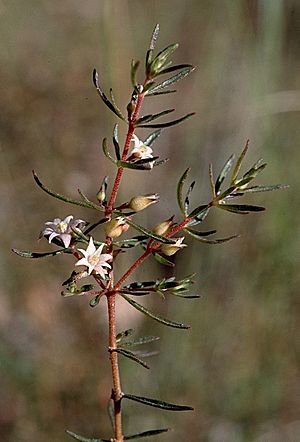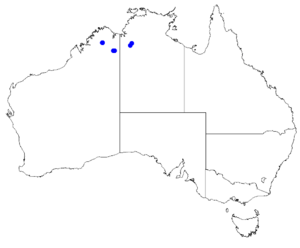Boronia jucunda facts for kids
Quick facts for kids Boronia jucunda |
|
|---|---|
 |
|
| B. jucunda in the Kimberley | |
| Conservation status | |
| Scientific classification | |
 |
|
| Occurrence data from Australasian Virtual Herbarium |
Boronia jucunda is a special plant that belongs to the citrus family, known as Rutaceae. It's a type of plant that grows only in a specific part of the world, which is the far north-west of Australia. This plant is a tall, bushy shrub with many branches. It has unique leaves that look a bit like feathers, and its flowers are white with four petals. You can only find Boronia jucunda in a small area of the Kimberley region in Western Australia and in a national park in the Northern Territory.
Contents
What Boronia jucunda Looks Like
Boronia jucunda is a shrub that stands tall, growing up to about 50 centimeters (20 inches) high. It has many branches, and both its branches and leaves are covered in tiny, star-shaped hairs. The leaves are made up of three narrow, finger-like parts called leaflets. The leaflet at the end is usually 8-42 millimeters (0.3-1.7 inches) long and 1-3 millimeters (0.04-0.1 inches) wide. The leaflets on the sides are a bit shorter and thinner.
The plant produces single white flowers. These flowers grow where the leaves meet the stem, on a very short stalk called a pedicel. The flower has four white sepals, which are like small leaves that protect the petals. These sepals are larger than the petals, measuring 4-5 millimeters (0.16-0.20 inches) long and about 2 millimeters (0.08 inches) wide. They even grow bigger as the fruit develops! The four white petals are about 4 millimeters (0.16 inches) long and 1 millimeter (0.04 inches) wide. Boronia jucunda usually blooms between May and June.
How Boronia jucunda Got Its Name
The plant Boronia jucunda was officially described for the first time in 1997 by a scientist named Marco F. Duretto. He published its description in a scientific journal called Nuytsia.
The second part of its scientific name, jucunda, comes from a Latin word that means "pleasing" or "delightful." This name was chosen because the leaves of the plant have a pleasant smell when you gently crush them.
Where Boronia jucunda Lives
Boronia jucunda prefers to grow in open woodlands. It especially likes rocky areas where there isn't too much grass. You can find this plant near the edge of a place called Winnama Gorge in the eastern part of the Kimberley region. It also grows in the Judbarra National Park in the Northern Territory.
Protecting Boronia jucunda
This special boronia plant is considered "Priority One" by the Government of Western Australia's Department of Parks and Wildlife. This means that it is known to grow in only a few places, and these locations might be at risk. Because it's so rare and only found in specific spots, it's very important to protect Boronia jucunda so it can continue to thrive in the wild.


